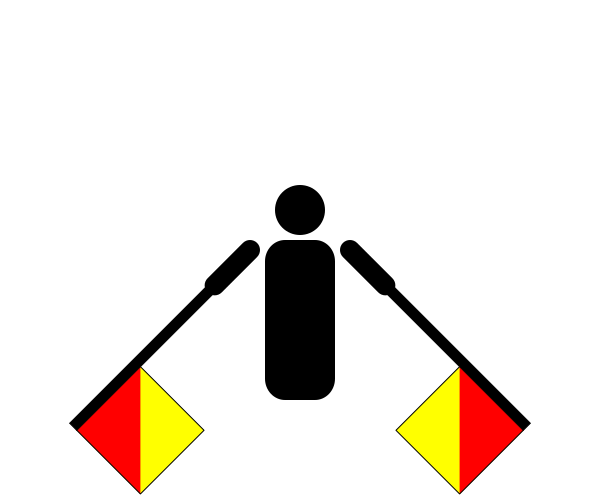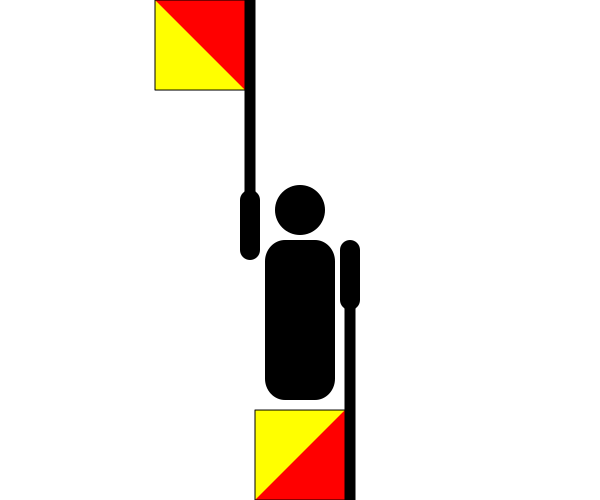
The first peace badge, 1958, made in ceramic for the Campaign for Nuclear Disarmament by Eric Austen from Gerald Holtom's original design.
The internationally recognized symbol for peace (☮) was originally designed for the British nuclear disarmament movement by Gerald Holtom in 1958.[49] Holtom, an artist and designer, made it for a march from Trafalgar Square, London to the Atomic Weapons Research Establishment at Aldermaston in England, organised by the Direct Action Committee to take place in April and supported by the Campaign for Nuclear Disarmament (CND).[49][50][51][52] Holtom's design, the original of which is housed in the Peace Museum in Bradford, England, was adapted by Eric Austen (1922–1999) to ceramic lapel badges.[53][54]
The symbol is a combination of the semaphore signals for the letters "N" and "D," standing for "nuclear disarmament".[49] In semaphore the letter "N" is formed by a person holding two flags in an inverted "V," and the letter "D" is formed by holding one flag pointed straight up and the other pointed straight down. Superimposing these two signs forms the shape of the centre of the peace symbol.[49][55][56]

Semaphore for "N"

Semaphore for "D"
Holtom later wrote to Hugh Brock, editor of Peace News, explaining the genesis of his idea in greater depth: "I was in despair. Deep despair. I drew myself: the representative of an individual in despair, with hands palm outstretched outwards and downwards in the manner of Goya's peasant before the firing squad. I formalised the drawing into a line and put a circle round it."[56] Ken Kolsbum, a correspondent of Holtom's, says that the designer came to regret the symbolism of despair, as he felt that peace was something to be celebrated and wanted the symbol to be inverted.[57] Eric Austen is said to have "discovered that the 'gesture of despair' motif had long been associated with 'the death of man', and the circle with 'the unborn child',"[53] possibly referring to images in Rudolf Koch's The Book of Signs, (Das Zeichenbuch, 1923) an English edition of which had been published in 1955.[58]

The Third of May 1808 by Goya, referred to by Gerald Holtom as one of his inspirations for the peace sign - although he said that the peasant had his hands stretched downwards.
The symbol became the badge of CND and wearing it became a sign of support for the campaign for unilateral nuclear disarmament by Britain. An account of CND's early history described it as "a visual adhesive to bind the [Aldermaston] March and later the whole Campaign together ... probably the most powerful, memorable and adaptable image ever designed for a secular cause."[53]
Not patented or restricted, the symbol spread beyond CND and was adopted by the wider anti-war movement. It became known in the United States in 1958 when Albert Bigelow, a pacifist protester, sailed a small boat fitted with the CND banner into the vicinity of a nuclear test.[59] Buttons with the symbol were imported into the United States in 1960 by Philip Altbach, a freshman at the University of Chicago. Altbach had traveled to England to meet with British peace groups as a delegate from the Student Peace Union (SPU) and on his return he persuaded the SPU to adopt the symbol. Between 1960 and 1964 they sold thousands of the buttons on college campuses. By end of the decade it had become a generic peace sign,[60] crossing national and cultural boundaries.[61]
From about 1970, opponents of the peace movement sought to find discreditable meanings for the peace sign.[62] There was a belief on the political right that it "represents a broken cross or a Communist-inspired anti-Christian device".[63][64] A national Republican newsletter was reported to have "noted an ominous similarity to a symbol used by the Nazis in World War II". [65] These ideas have recently become widespread on right-wing, fundamentalist Christian and occultist websites.[66]
Source: Wikipedia.org


Comments
How Totally Cool !!
I Thank You Sister Rain for bringing this precious remembrance up and out ! You know how to dig'm up! . Peace out
Arms down is “despair” and arms up is “joy”
A little more insight into the history of the peace symbol.
Peace Symbol with Arms Raised:
http://focusfusion.org/index.php/site/article/peace_symbol_with_arms_raised
The Peace Meditation:
http://www.theyfly.com/salome/salome.htm